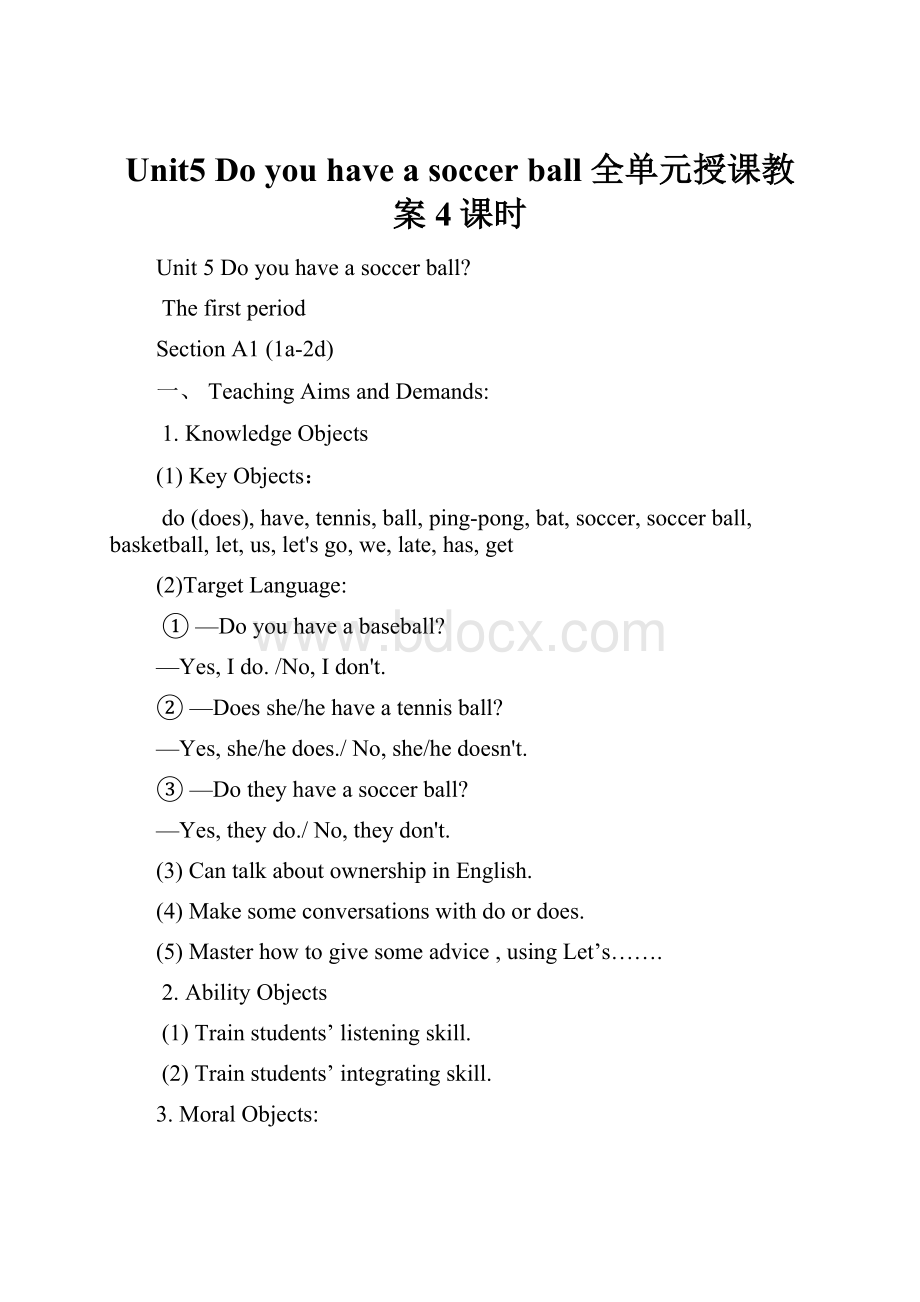Unit5 Do you have a soccer ball 全单元授课教案4课时.docx
《Unit5 Do you have a soccer ball 全单元授课教案4课时.docx》由会员分享,可在线阅读,更多相关《Unit5 Do you have a soccer ball 全单元授课教案4课时.docx(23页珍藏版)》请在冰豆网上搜索。

Unit5Doyouhaveasoccerball全单元授课教案4课时
Unit5Doyouhaveasoccerball?
Thefirstperiod
SectionA1(1a-2d)
一、TeachingAimsandDemands:
1.KnowledgeObjects
(1)KeyObjects:
do(does),have,tennis,ball,ping-pong,bat,soccer,soccerball,basketball,let,us,let'sgo,we,late,has,get
(2)TargetLanguage:
①—Doyouhaveabaseball?
—Yes,Ido./No,Idon't.
②—Doesshe/hehaveatennisball?
—Yes,she/hedoes./No,she/hedoesn't.
③—Dotheyhaveasoccerball?
—Yes,theydo./No,theydon't.
(3)CantalkaboutownershipinEnglish.
(4)Makesomeconversationswithdoordoes.
(5)Masterhowtogivesomeadvice,usingLet’s…….
2.AbilityObjects
(1)Trainstudents’listeningskill.
(2)Trainstudents’integratingskill.
3.MoralObjects:
Encouragestudentstotalkaboutownershipwiththeirfavoritesports.LetthestudentsliketheteachingactivitiesinEnglishclass.
二、Teachingkeyanddifficultpoints:
1.TeachingKeyPoints:
:
(1)CantalkaboutownershipinEnglish.
(2)Makesomeconversationswithdoordoes.
(3)Masterhowtogivesomeadvice,usingLet’s…….
2.TeachingDifficultPoints:
:
(1)Learntaskandanswerthequestionswithdoordoes.
(2)CantalkaboutownershipinEnglish.
(3)Masterhowtogivesomeadvice,usingLet’s…….
三.TeachingMethods:
1.Teachingbyexplanation.
2.Pairwork.
四.TeachingAids:
1.Picturesofsports.
2.Ataperecorder.
五.Classtype:
Thenewteaching
六.TeachingProcedures:
Step1.Presentation
1.Presentthekeyvocabulary.
(Showabasketballtotheclass.)
T:
What’sthisinEnglish?
S1:
It’sabasketball.
T:
Yes,youareright.Readafterme.B-A-S-K-E-T-A-B-L-L,basketball.
Ss:
B-A-S-K-E-T-A-B-L-L,basketball.
(Showthestudentsotherobjects.Teachthenewwords“soccerball,ping-pongball,volleyball,tennisbat,ping-pongbat”inthesameway.)
T:
Readthewordstogethertwice.
Ss:
…
2.Lookatthewordsin1aandmatchthewordswiththethingsinthepicture.
T:
Number1is(a),tennisball.What’sNumber2Matchthem.
Askonestudenttoshowtheanswersandcheckthem.
3.Presentthekeystructure.
Presentthesequestionsandanswers.
(Pointtoastudentwhohasapencilbox.)
T:
Doyouhaveapencilbox?
S1:
Yes,Ido.(Nodyourheadyes)
T:
(AskS2)Doesshehaveapencilbox?
S2:
(HelpS2answer)Yes,shedoes.
T:
Doyouhaveabasketball?
S1:
No,Idon’t.(Shakeyourheadno)
T:
(AskS2)Doesshehaveabasketball?
S2:
(HelpS2answer)No,shedoesn't.
Practicethedrill“Doyouhavea…?
”,"Doeshe/shehavea…?
"inpairs.Youcanuse
yourschoolthingsandtheseballs.Lookatthemodel,thenpracticelikethis.
Model:
S1:
Doyouhaveabasketball?
S2:
Yes,Ido.
S3:
Doseshehaveabasketball?
S4:
Yes,shedoes.
S1:
Doyouhaveasoccerball?
S1:
No,Idon’t.
S3:
Doseshehaveasoccerball?
S4:
No,shedoesn't.
(Studentsworkinpairs.)
Step2.Listening
T:
Lookatthefouritemsof1binthepictures.Listentotheconversation.
(Playtherecordingof1bthefirsttime.Studentsonlylisten.)
T:
Listentotheconversationandcirclethewordsyouhear.
(Playtherecordingagain.)
T:
Checktheiranswers.
S1:
…S2…
Step3.Pairwork
1.Readtheconversationsin1c.(Askstudentstorepeat.)
2.Lookatthepicturein1aandpracticetheconversationwitheachotherinpairs.
S1:
Doyouhave…?
S2:
Yes,Ido.
S1:
Doyouhavea…?
S2:
No,Idon’t.
3.Workingroupsoffourandusethepicturetopracticethesimilarconversationswiththenewwords.(basketball,baseballbat,soccerball,volleyball,computer,ping-pongbat,baseball)
T:
Askandanswerthequestionsasmanyasyoucan.
S1:
Doyouhavea…?
S2:
…
S1:
…
S2:
…
Step4.Listening
1.T:
Lookatthepicturesin2bandnamethem.Whatarethese?
(Pointatthebaseball,basketball,soccerball,volleyball.)
Ss:
Theyare…
T:
Therearefourchildrenintheconversations.Whoarethey?
Pleaselistenandfindtheanswer.
(Playtherecorderforthefirsttime.)
S:
…
T:
I’llplaytherecorderforthesecondtime.Listenandnumberthepictures(1-4).
(Studentslistenforthesecondtime.)
T:
Listentotheconversationin2b.Matchthepeoplewiththeballs.
(Studentslistenandmatch.Teachercheckstheiranswer.)
Step5.Pairwork
1.T:
Let’slookatthepicturein2a.DoesJanehaveatennisball?
S1:
No,shedoesn't.
T:
DoesPaulhaveasoccerball?
S2:
No,hedoesn't.
T:
Doeshisbrotherhaveasoccerball?
S2:
Yes,hedoes.
(Askmorestudentstomakeaconversation.)
T:
Makeconversationswiththingsinthepicture.
S:
…
2.Asksomepairstoactouttheirconversations.
Step6.Presentation
(Showasoccerballtoclass.)
T:
Let’splaysoccerballafterclass,OK?
S1:
OK.
T:
Let’splayping-pong.
S2:
OK.
T:
Weoftenusethedrill“Let’s…”tomakeasuggestion.Ifyouwanttodoit,youmaysay“OK./Thatsoundsgood./Allright…”Ifyoudon’twanttodoit,youmaysay“No,Idon’thavea…”
(Theteacherwritesthedrillonthebackboard.)
A:
Let’splay…
B:
No,Idon’thavea…
A:
Well,let’splaybaseball.
B:
OK.Let'sgo.
Ssreadtheconversationandtrytorememberthem.
Step7.Role-play
1.CindyandHelenwanttoplaybaseball.Nowreadtheconversationandmatchthethingswiththeirrightplaces.
baseballonthechair
baseballbatinCindy'sbag
Cindy'sjacketBillhasit.
2.Readtheconversationaftertheteacher.
3.Practicetheconversationwithyourpartner.
4.Asksomepairstoactoutthedialogueinfrontoftheclass.
Step8.Explanation
Explainthosekeywordsandexpressions.Letthestudentsusethemcorrectly.
Step9.Exercises
Makeupthenewconversationsinpair.Letsomestudentsactitinthefrontoftheclass.
Step10Summary
Inthisclass,we’vemainlylearnedthe“have“structure.Askthestudentsmakeupthesempleconversations.
Step11Homework
1.Reviewthenewwordsinthislesson.
2.Makeupthenewconversationswiththeword“have”.
Theblackboarddesign:
Unit5Doyouhaveasoccerball?
Doyouhaveaping-pongbat?
Yes,Ido.
Doyouhaveaping-pongbat?
No,Idon’t.
Thesecondperiod
SectionA2(GrammarFocus-3c)
一、TeachingAimsandDemands:
1.KnowledgeObjects
(1)KeyObjects:
do(does),have,tennis,ball,ping-pong,bat,soccer,soccerball,basketball,let,us,let'sgo,we,late,has,get
(2)TargetLanguage:
①—Doyouhaveabaseball?
—Yes,Ido./No,Idon't.
②—Doesshe/hehaveatennisball?
—Yes,she/hedoes./No,she/hedoesn't.
③—Dotheyhaveasoccerball?
—Yes,theydo./No,theydon't.
(3)Cantalkaboutownershipwiththeword“have”.
(4)Makesomeconversationswithdoordoes.
(5)Masterhowtogivesomeadvice,usingLet’s…….
2.AbilityObjects
(1)Trainstudents’writingskill.
(2)Trainstudents’integratingskill.
3.MoralObjects:
Encouragestudentstotalkaboutownershipwiththeirfavoritesports.LetthestudentsliketheteachingactivitiesinEnglishclass.
二、Teachingkeyanddifficultpoints:
1.TeachingKeyPoints:
:
(1)CantalkaboutownershipinEnglish.
(2)Makesomeconversationswithdoordoes.
(3)Masterhowtogivesomeadvice,usingLet’s…….
2.TeachingDifficultPoints:
:
(1)Learntaskandanswerthequestionswithdoordoes.
(2)CantalkaboutownershipinEnglish.
(3)Masterhowtogivesomeadvice,usingLet’s…….
三.TeachingMethods:
1.Teachingbydemonstration.
2.Pairwork.
四.TeachingAids:
1.Picturesofsports.
2.Ataperecorder.
五.Classtype:
Thenewteaching
六、TeachingProcedure:
Step1.Revision
LettheSsworkingroups(eachgrouphasthreeSs).Reviewthesentencestructureswe
havelearned.
S1:
Doyouhaveabasketball?
S2:
Yes,Ido.
S1:
Doesshehaveabasketball?
S3:
Yes,shedoes.
S1:
Doyouhaveatennisbat?
S3:
No,Idon't.
S1:
Doeshehaveatennisbat?
S2:
No,hedoesn't.
…
Step2.GrammarFocus.
1.ReadGrammarFocusandfinishoffthesesentences.
①你有一个棒球吗?
____you_____abaseball?
②是的。
___,I____.不,没有。
_____,I______.
③你有一个乒乓拍吗?
____you_____aping-pong_____?
④没有。
我有一个乒乓球。
_____,I______.I_____aping-pong_______.
⑤她有一个网球吗?
____she_____atennis?
⑥是,她有。
没有。
她有一个棒球。
_____,she_________.____,she________.She____a______.
⑦他有一个足球吗?
_____he_____a_____ball?
⑧没有。
他有两个乒乓球拍。
____,he________.He____twoping-pong______.
⑨他们有一个篮球吗?
___they_____abasketball?
⑩是的,有。
没有。
他们有一个排球。
Yes,__________.____,they______.They______a________.
写出下列表达方式的缩写形式
①donot=________②doesnot=______
③weare=______④letus=________.
2.Summary
1)have意为“有”,表示某人所有某物。
have在句子中有两种形式,即have和has。
have用于第一人称(I,we)、第二人称(you)以及第三人称复数(they)和其他复数名词;而has则用于第三人称单数(he,she,it)和单数名词。
如:
Ihaveanapple.我有一个苹果。
Maryhasanorange.玛丽有一个桔子。
2)have/has句子的一般疑问句是在句首加助动词do或does,句尾用问号构成。
除第三人称单数前用does外,其他都用do。
第三人称单数前加does后,句中的谓语动词has应改为have。
作简略回答时,肯定回答为:
“Yes,主语+do/does.”,否定回答为:
“No,主语+don’t/doesn’t.”。
Step3.Writing
1.指导:
英语句子中的人称和数
人称
汉语
主格
助动词
宾格
单
数
第一人称
我
I
do
me
第二人称
你
you
you
第三人称
他,Eric等
he
does
him
她,Linda等
she
her
它
it
it
复
数
第一人称
我们
we
do
us
第二人称
你们
you
you
第三人称
他们,她们,它们
they
them
2.Ssdiscusswiththeirpartnerandfillinthechart.
3.Checktheanswers.
Step4.Practice
1.指导:
实义动词的一般疑问句结构。
①当主语是第一人称/第二人称/第三人称复数时,句型结构为:
Do+you/they/we/…+动词原形+…?
不管用什么动词,它的回答是固定的。
肯定回答:
Yes,I/they/we…do.
否定回答:
No,I/they/we…don’t.
②当主语是第三人称单数时(she,he,it,Linda,Bob及名词的单数形式anapple),句型结构为:
Does+she/he/it/…+动词原形+…?
不管用什么动词,它的回答是固定的。
肯定回答:
Yes,she/he/it…does.
否定回答:
No,she/he/it…doesn’t.
2.Notes:
①play+球类意为“玩、打……”playsoccer,playvolleyball,playbasketball,playping-pong
②Thatsoundsgood.那听起